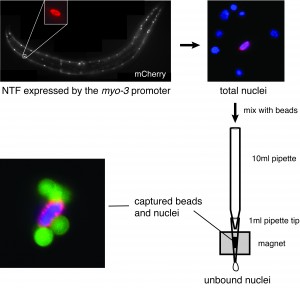Within a multicellular organism, cells differentiate from pluripotent progenitors to specialized cells by programmed changes in gene expression. To follow both gene expression changes and underlying alterations in the chromatin landscape, sufficient amounts of homogenous cell types are required. In some organisms, this is conveniently accomplished using cell lines, however, none are currently available for C. elegans. Alternatively, the purification of RNA and chromatin from specific cell types from whole worms can potentially bring the powerful tools of epigenomic analysis to developmental studies.
We have recently described a method that is suitable for simultaneous examination of expression and chromatin profiles (Steiner et al., 2012). This method, termed INTACT (Isolation of Nuclei TAgged in specific Cell Types), was originally applied to Arabidopsis (Deal and Henikoff, 2011). INTACT is based on in vivo biotin-labeling of the nuclear envelope and subsequent affinity purification of nuclei. To target worm nuclei, we have used the outer nuclear pore protein NPP-9 fused to mCherry and a biotin ligase recognition peptide (BLRP) as a nuclear tagging fusion (NTF), and co-expressed the E. coli biotin ligase BirA, which specifically biotinylates the BLRP (Steiner et al., 2012). Biotinylated target nuclei can be affinity purified using magnetic streptavidin beads and a simple flow column inserted into a magnet (Figure 1).
C. elegans is an ideal model for applying INTACT, as the cell lineages are largely invariant and fully mapped, making it possible to target defined lineages and cell types down to single cells. For many cell types, promoters with tight expression patterns have been described, allowing to target them at all developmental stages. As proof of principle, we have targeted the muscle cells of adult C. elegans by using the muscle specific myo-3 promoter to drive NTF expression and a ubiquitous his-72 promoter to drive BirA expression.
In a typical experiment, we use about 1 ml of packed worms (~500,000 worms) to affinity purify ~1-2 million muscle nuclei. We compared nuclear RNA from these nuclei to nuclear RNA from whole worms, and identified hundreds of genes that are specifically expressed in muscle tissues. We also compared nucleosome occupancy profiles derived from muscle and total nuclei, and found that these genes are depleted of nucleosomes at promoters and gene bodies in muscle relative to other tissues. Moreover, we used INTACT to identify genes that are down-regulated in an unc-120 mutant. Although some of these genes could be identified by comparing RNA profiles derived from whole N2 and unc-120(st364) worms, we found that the sensitivity of detecting expression differences between the two strains was greatly enhanced when we analyzed RNA from affinity-purified muscle nuclei.
The method is thus well suited to study gene expression and chromatin landscapes of specific cell types at all stages of development and should be applicable to all cell types and lineages for which specific promoters have been described.
Figures

References
Deal RB, and Henikoff S. (2011). The INTACT method for cell type-specific gene expression and chromatin profiling in Arabidopsis thaliana. Nature prot. 6, 56-68. 
Steiner FA, Talbert PB, Kasinathan S, Deal RB, and Henikoff S. (2012). Cell-type-specific nuclei purification from whole animals for genome-wide expression and chromatin profiling. Genome Res. 22, 766-777. 




